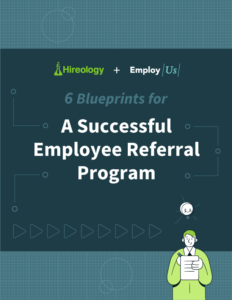How many times a day does your job come up in casual conversation outside of the workspace?
Think about it: one of the first questions people typically ask each other when meeting is “What do you do for a living?” Now, what if we told you that this brief moment of dialogue could easily become one of the best ways to recruit for your company’s open positions?
If your organization implements an employee referral program — and runs it correctly — your best employees can become some of your best recruiters. Good people know good people, and at this point in the hiring market, if your staff have stayed on your team for an extended period of time, there’s a high likelihood that they perform their jobs well.
Read on to learn more about employee referral programs and some of the most frequently asked questions we hear about them.
Frequently asked questions about employee referral programs
What is an employee referral program?
An employee referral program is best described as a recruitment strategy that sources candidates from your existing staff. Your best employees have vast networks of friends, colleagues, and former coworkers — some of which may just be open to switching jobs.
How do businesses benefit from running an employee referral program?
There are a lot of benefits to running an employee referral program. Referred candidates are generally hired faster, stay longer, and are more engaged in the workspace than non-referred candidates — making referrals an applicant source you can’t afford to ignore. Plus, your employees can become your best recruiters if they’re really driven by your program rewards!
When you place recruiting in the hands of your existing employees, you open up the opportunity to save money on a variety of forefronts. Firstly, you start off by saving money per hire — simply because you’re not wasting time waiting for applicants to trickle in from often costly sponsored posts. Secondly, when you have an employee referral program in place with the right incentives, you improve your employees’ overall morale; they feel heard and appreciated for going above and beyond to help you make their next hire, plus they now get to work with a friend! This can ultimately improve your overall company reputation as well, leading to more applicants flowing organically through your job postings if word gets around.
How do employee referral programs work?
Generally speaking, employee referral programs follow this schedule:
- A role opens up
- HR determines the value/reward associated with help recruiting for this position
- HR relays the opening and congruent reward to the company as a whole
- Collect referred candidate’s basic information
- Reach out to the referred candidates with an invitation to apply
- If a referred candidate is hired, the company follows through on its payout/reward to the referring employee
Now this seems pretty straightforward, but there are a couple of areas we’d like to clarify.
For one, not every open position will offer the same incentive for a new hire. The value of the motivation should be determined by how hard the role is to fill. For instance, an entry-level position is considerably easier to fill than an SVP. Traditionally speaking, entry-level positions offer financial compensation anywhere between $250 – 500; if your company chooses not to offer money as a motivator, then consider incentives that are valued within this range.
Secondly, this whole process relies entirely on your organization’s follow through. Delays in paying out referral bonuses or clunky processes that drag out discourage your employees from participating, as the incentives they were promised only become harder and harder to achieve. In order for your program to work, your company needs to make sure that it runs seamlessly.
How do I create an employee referral program at my organization?
Creating an employee referral program for your organization is easier than you may think! This is one of those instances where it’s helpful to learn from other, larger organization’s trial and error. There’s no sense in wasting time trying to reinvent the wheel; instead, consider two or three employee referral program models that would make sense at your organization and pick the one that makes the most sense for you. If it doesn’t work, you always have the opportunity to try other methods of operating until you find one that works for your business.
After picking the way that you want your employee referral program to operate, the next thing to do is to pick pragmatic goals and outline your policies. This policy document will outline every detail of your employee referral program, from how referrals are gathered to when employees will receive payouts for their referred candidates. It’s really important to create an easy referral process so that your employees will experience as little friction as possible when they submit referrals. After you have all of these details hammered out, the only thing left to do for your employee referral program is to start promoting it.
Imitation is the highest form of flattery. Follow the blueprint to a successful employee referral program from some of the best organizations in the world!
How do employees participate in the referral program?
There are a few ways that you can solicit referrals through your employee referral program, but the main idea is to make it as simple as possible for your employees to participate.
Only ask your employees to submit the contact information of the candidates they’re referring — you can collect detailed information during the hiring process. By being creative with the submission channels you offer your employees, you can make this possible. Instead of asking people to fill out long forms or download apps, make applying as easy as sending a text or scanning a QR code.
Do referred candidates need to complete an application?
Yes, referred candidates will still need to complete an application for your open roles. Even if one of your top employees let them know about this opportunity, your HR department will still need to do their due diligence in the hiring process to remain compliant. This means keeping track of where the candidate is at in your hiring process, as well as flagging them as hired in your applicant tracking system once you decide to make them your next hire.
What are the types of incentives that I can offer to drive participation in my employee referral program?
There’s a range of options for what you can offer your employees for referring candidates that turn into your next hire. What matters most is that you follow through with what you promise.
Typically, the most successful employee referral programs offer the following types of motivations:
- Cash
- Gift cards
- Additional PTO
- Prizes, like new technology
- A day at the spa
- Charitable donations in their name
- Ask them what they would like to receive
As noted earlier, it’s important that what you choose to offer in terms of incentives aligns with how difficult it is to fill the role.
Are there ways to make running an employee referral program easier?
Yes, there are! By using designated software to manage your employee referral program, you improve the overall efficiency of your program and drive ROI by giving your team time back in your day to perform other, just as necessary, tasks. Plus, you’ll no longer be required to toggle from spreadsheet to spreadsheet and manually track referral payouts since all of that sensitive data will be stored in one centralized platform.
Another way that employee referral tools make running an employee referral program easier is by allowing you to track where the bottlenecks are occurring in your referral program via insights so you can continue to improve over time. These metrics allow you to pinpoint inefficiencies so that you can optimize your program and drive hiring while increasing ROI.
Finally, if you choose to use an employee referral tool, make sure that it integrates with your existing payroll provider. By ensuring that your referral payouts are sent out on time — and tracked correctly — you keep your best recruiters happy and your program running smoothly.
According to our applicant study from earlier this year, 20% of new hires found their most recent role through a referral. Learn how to capture this applicant pool here!
So much of an employee referral program’s success comes from careful planning and implementation. You need to set up a solid foundation before you can see the results you want. With these questions and answers in mind, however, you’ll be more prepared than ever to create an employee referral program at your organization that drives hiring, proves its ROI, and makes your employees appreciate your business even more.
Getting started doesn’t have to be difficult — with Hireology Referrals, you have everything you need at your fingertips to create an employee referral program that drives hiring. To see this employee referral tool in action, connect with a trained representative today!





